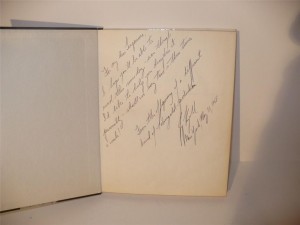We’ve talked previously about what may happen to book covers as e-books become more prevalent. But the VQR blog has a nice post about another vanishing aspect of paper books: marginal notes, flyleaf dedications, and physical insertions.

Says blogger Megan Alix Fishmann, who works in a used bookstore:
Each receipt, torn article, and note is a clue leading me to learn just a bit more about the book’s previous owner. In 125 Cookies to Bake, Nibble & Savor, in the midst of a recipe for peanut butter cookies, I found a woman’s prescription for 15mg of Terazepam, a strong sleeping medication. In a first edition of Margaret Atwood’s Oryx & Crake, Nan Talese—the book’s publisher—had written a letter to someone in beautiful script: “Here with O&C, with great pride and pleasure. All my best, Nan. April 2003.” A postcard of William S. Burroughs was used as a bookmark between the pages of Gertrude Himmelfarb’s On Looking into the Abyss. […]
What will eventually become of these books with their treasure trove of notes and inscriptions? Electronic books are just pixels on a screen. These personal connections to the past make physical books so much more than that.
When I go through my old books, I sometimes find receipts that remind me of when and where I bought it, pressed flowers, shopping lists, notes to myself or from the person who gave me the book. I like borrowing books from friends and seeing which pages they’ve dog-eared, or where the spine splits at a much-loved, much-read passage. And one of my favorite books is my husband’s copy of Milton’s Paradise Lost, because of his notes from the ninth grade in the margins. (“Satan sees Eve alone … woot.”) Digital books have their pros, of course, but Fishmann is right: books that we’ve known and handled often have a personal, physical connection to the past that e-books won’t be able to capture.



